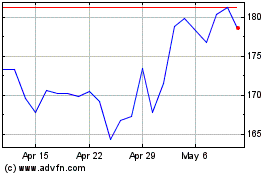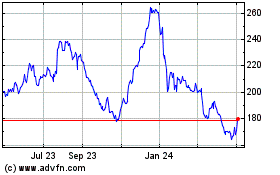By Andy Pasztor
Boeing Co.'s engineering mistakes and "culture of concealment,"
coupled with insufficient federal safety oversight, led to two
fatal crashes of the plane maker's 737 MAX aircraft, House
investigators said in a report released Friday.
The preliminary findings, issued by Democrats on the House
Transportation Committee, describe in stark terms the engineering
and regulatory lapses revealed in five public hearings over the
past year into the design and certification of the MAX, which was
grounded around the world last March following a second crash of
the passenger jet.
The crashes of the Ethiopian Airlines flight and the Lion Air
flight five months earlier, claimed a total of 346 lives. The
protracted grounding continues as Boeing works on software fixes
and develops pilot-training requirements that will win the approval
of regulators. Boeing halted the aircraft's production in
January.
Friday's report details Boeing's determination at various levels
-- years before the MAX was approved by the Federal Aviation
Administration -- to avoid putting pilots through costly
ground-simulator training. That single-minded goal was evident
across Boeing's engineering, marketing and management ranks,
according to the report, and resulted in various efforts to mislead
or withhold information from FAA officials during the lengthy
certification process.
Both crashes occurred after pilots failed to counteract a new
automated flight-control feature -- details of which they didn't
know -- that misfired to repeatedly and aggressively push down the
nose of their aircraft.
The 13-page congressional report offers new details about what
it described as Boeing's improper conduct related to MAX, including
fresh insight into the period during the plane's development and in
the weeks after the first crash.
In July 2014, three years before the MAX started flying
passengers and two years before the FAA made a decision regarding
the extent of mandatory pilot training, the report says Boeing
issued a press release seemingly predetermining the regulatory
process. The company said pilots already flying earlier 737 models
"will not require a simulator course to transition to the 737 MAX."
According to the report, Boeing made the same pledge to airliner
customers, including Ethiopian Airlines.
During the plane's development, Boeing successfully argued to
remove references to the flight-control system, known as MCAS, from
official manuals. As the House committee revealed earlier, the
company also went to great lengths to keep FAA officials from
scrutinizing and potentially recognizing the hazards of the system,
even referring to it by another name.
The FAA's oversight effort was "grossly insufficient and...the
FAA failed in its duty to identify key safety problems," according
to the report.
The FAA said the agency welcomes the scrutiny and the lessons
from the two crashes would bolster aviation safety.
A Boeing spokesman said, "We have cooperated extensively for the
past year with the committee's investigation; we will review this
preliminary report."
The report offered fresh insight into Boeing's actions after the
first crash in Indonesia. The panel concluded that Boeing continued
to minimize the importance of MCAS -- and persisted in deflecting
the need for additional pilot training -- even in the wake of the
Lion Air crash in October 2018 and stepped-up FAA assessments of
the system's hazards.
Based on hundreds of thousands of pages of internal documents
and other material Boeing turned over to the committee, the report
spells out steps Boeing took to defend itself in the weeks after
the Lion Air crash. At the time, the report indicates, Boeing
maintained that design changes that had made MCAS more powerful
complied with all safety rules and requirements.
Despite the Lion Air crash and the public outcry it created,
Boeing sought to persuade the FAA to downgrade training
requirements on MAX jets in general, according to House
investigators. Their report says the effort by Boeing came in the
face of regulators' warnings that the company's technical
evaluation of the issue was at odds with the views of FAA
experts.
The report reiterates earlier complaints by lawmakers that the
Chicago-based aerospace giant was able to exert undue influence
over the FAA, partly because regulators delegated much of their
oversight responsibilities to Boeing employees authorized to act on
the government's behalf.
It also detailed examples of FAA managers overruling safety
concerns of their own technical experts related to another Boeing
airliner, the Boeing 787.
The Democratic-controlled House committee intends to continue
its probe, but Rep. Peter DeFazio, the Oregon Democrat who chairs
the panel, surprised some industry officials and prompted blowback
from Republican members by opting to release a preliminary report.
Coming days before the anniversary of the Ethiopian Airlines MAX
crash in March 2019, Democrats hope the material will provide
momentum for significant legislative changes tightening FAA
oversight.
Rep. DeFazio sought to avoid a partisan rupture during the
committee hearings. But hours after the report came out, a pair of
senior GOP panel members issued a rebuttal suggesting its
conclusions were premature and potentially biased. The Republican
statement said other reviews of the FAA's approval process for new
aircraft designs haven't concluded the "system is broken or in need
of wholesale dismantlement."
The minority report said that rather than rushing out a report
to meet an artificial timeline, "we need to get this right" and
"fix the problems that need to be fixed to make our fundamentally
safe system even safer."
While the document lays out a pattern of Boeing moves "to
obfuscate information about the operation of the aircraft," it
equally targets the FAA for inadequate safeguards and disjointed
internal communications.
Even following the Lion Air crash, according to House
investigators, the FAA missed red flags that should have alerted it
about the extent of Boeing's previous failure to adequately test
the combined impact of various sensor and other malfunctions that
could result in MCAS activation. Boeing and the FAA quickly agreed
the system's software needed a major redesign, though the report
indicates FAA officials allowed the plane to keep flying despite
multiple prior certification blunders pertaining to the MAX.
Separately, in Boeing's latest reported production lapse, the
FAA on Friday proposed a $19.7 million penalty against the company
for installing unapproved sensors on nearly 800 jetliners,
including 173 of its 737 MAX models.
The alleged missteps, extending from mid-2015 to the spring of
2019, highlight Boeing failures to comply with its own
quality-control rules covering aircraft production. The proposed
civil penalty, at the upper end of what regulators could seek based
on the number of affected aircraft, also reflects increased FAA
scrutiny of Boeing's assembly-line safeguards.
Covering more than 600 earlier 737 models, the enforcement case
stems from alleged Boeing slip-ups in failing to ensure sensors
associated with certain windshield cockpit displays had been
approved by regulators for specific applications. The letter to
Boeing laying out the details, dated Friday, doesn't indicate any
operational safety incidents as a result of the alleged
violations.
A Boeing spokesman said the company has done a thorough internal
review and implemented changes to address the FAA's concerns.
Write to Andy Pasztor at andy.pasztor@wsj.com
(END) Dow Jones Newswires
March 06, 2020 18:46 ET (23:46 GMT)
Copyright (c) 2020 Dow Jones & Company, Inc.
Boeing (NYSE:BA)
Historical Stock Chart
From Jun 2024 to Jul 2024

Boeing (NYSE:BA)
Historical Stock Chart
From Jul 2023 to Jul 2024
